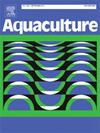LED 光谱对红鲷鱼视觉、食欲和生长的影响
IF 3.9
1区 农林科学
Q1 FISHERIES
引用次数: 0
摘要
鱼类能感知不同类型的光,不同物种生长、发育或繁殖的最佳光照制度(强度、光谱、光周期)也各不相同。在生理学上,眼睛的视网膜将光转换成电信号并发送到大脑,由下丘脑产生内分泌激素,刺激摄食行为、抑制或激发食欲等反应。本研究调查了各种 LED 光谱对红鲷鱼(Pagrus major)视觉、食欲和生长的影响。实验组使用的圆柱形水槽装有 LED 盖,可发出红光(660 nm)、绿光(518 nm)、蓝光(450 nm)和白光(全光谱)(光照度均为 150 lx)。光周期设定为 12 L: 12D 周期。12 周后,在 LED 蓝光下饲养的鱼体重最大,为 336.61 ± 63.11 克,其次是绿光(318.95 ± 62.06 克)、白光(308.16 ± 47.13 克)和红光(271.32 ± 45.15 克)。视网膜结构的变化表明,红色 LED 实验组的视网膜较薄,而蓝色 LED 实验组的视网膜最厚(P < 0.05)。红色实验组的 Rh1、Rh2A、Rh2B 和 LWS mRNA 表达量最高,而蓝色实验组的 SWS2 表达量最高(P < 0.05)。蓝色实验组的食欲促进肽水平明显更高,而红色实验组的食欲抑制肽水平更高(P < 0.05)。与氧化应激有关的 HSP70 和 SOD 的基因表达在红色实验组中升高(P < 0.05)。这些结果表明,蓝光能促进食欲和生长,但不会对视网膜造成损伤,而红光则会产生相反的效果。因此,研究结果表明,蓝光可用作提高红鲷养殖产量的可控光照策略。本文章由计算机程序翻译,如有差异,请以英文原文为准。
Effect of LED spectrum on the vision, appetite, and growth of red seabream (Pagrus major)
Fish perceive different types of light, and the optimal light regime (intensity, spectrum, photoperiod) for growth, development, or reproduction varies across different species. Physiologically, the retina of the eye converts light into electrical signals and sent to the brain, with the hypothalamus producing endocrine hormones stimulating responses such as feeding behavior and appetite suppression or incitement. In the current study, the effects of various LED spectrum on the vision, appetite, and growth of red seabream (Pagrus major) were investigated. Cylindrical tanks equipped with LED covers emitting red (660 nm), green (518 nm), blue (450 nm), and white (full spectrum) light (all under 150 lx illumination) were used for the experimental groups. Photoperiod was set at 12 L: 12D cycle. Initially, red seabream (P. major) weighed 123.07 ± 15.25 g. After 12 weeks, fish reared under blue LED light weighed the most at 336.61 ± 63.11 g, followed by green (318.95 ± 62.06 g), white (308.16 ± 47.13 g), and red (271.32 ± 45.15 g). Changes in the retinal structure indicated that the red LED experimental group developed thinner retinas, whereas the blue LED group had the thickest retinas (P < 0.05). Rh1, Rh2A, Rh2B, and LWS mRNA expressions were highest in the red experimental group, while SWS2 was highest in the blue experimental group (P < 0.05). The blue experimental group exhibited significantly higher levels of appetite-promoting peptides, whereas the red experimental group had higher levels of appetite-suppressing peptides (P < 0.05). Gene expressions of HSP70 and SOD expressions, related to oxidative stress, were elevated in the red experimental group (P < 0.05). These results suggest that blue light enhances appetite and growth without causing retinal damage, while exposure to red light had the opposite effect. Thus, the findings illustrated that blue light can be used as a controlled lighting strategy for enhanced red seabream (P. major) aquaculture production.
求助全文
通过发布文献求助,成功后即可免费获取论文全文。
去求助
来源期刊

Aquaculture
农林科学-海洋与淡水生物学
CiteScore
8.60
自引率
17.80%
发文量
1246
审稿时长
56 days
期刊介绍:
Aquaculture is an international journal for the exploration, improvement and management of all freshwater and marine food resources. It publishes novel and innovative research of world-wide interest on farming of aquatic organisms, which includes finfish, mollusks, crustaceans and aquatic plants for human consumption. Research on ornamentals is not a focus of the Journal. Aquaculture only publishes papers with a clear relevance to improving aquaculture practices or a potential application.
 求助内容:
求助内容: 应助结果提醒方式:
应助结果提醒方式:


